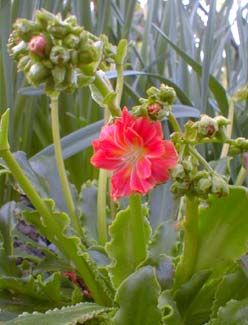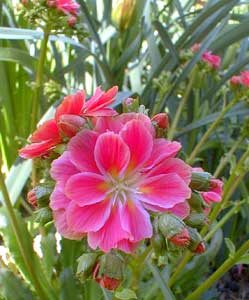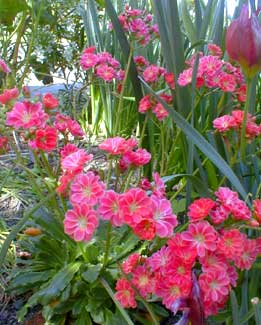
'Praline' Semi-Double Red
Siskayou Cliff Maidens
"Welcome, maids of honour!
You do bring
In the spring,
And wait upon her."
-Robert Herrick,
1591‚1674
1591‚1674
Lewisia cotylodon 'Praline' is a strain of semi-double bitterroot introduced in 1994. It produces a variable percentage of full or nearly full double flowers among the semi-doubles.
One never knows if it will be "merely" semi-double, or throw off a large number of actual or near-doubles.
 Though seed grown specimens are unpredictable, it is overall an improvement over the other commonly available semi-double strain, 'Regenbogen' aka 'Rainbow' from Germany, which is often only barely semi-double, whereas 'Praline' is always at least strongly semi-double.
Though seed grown specimens are unpredictable, it is overall an improvement over the other commonly available semi-double strain, 'Regenbogen' aka 'Rainbow' from Germany, which is often only barely semi-double, whereas 'Praline' is always at least strongly semi-double.Apparently 'Praline' is the same as 'Ashwood Strain.' Ashood Nursery itself calls their semi-double a "gambler's choice," while other vendors offer 'Praline' as a "take your chances" sort of plant. But even if you "lose" this game of chance, & you get a plant without many of the near-doubles, it is still floriferious, with every flower having more petals than on a regular lewisia.
Both of the major semi-double strains ('Praline' & 'Regenbogen') come in a range of colors. 'Praline' comes in apricot-yellow & bright fuchsia-pink & red. Ours flowers a rich rose red with just a hint of yellow about its edges.
Leaf-type varies a great deal from plant to plant, but the majority of intraspecies hybrids seem to be between L. cotyledon cotyledon which has smooth spoon-shaped leaves, & L. cotyledon howellii which has wrinkly-edged spoon-shaped leaves. This particular 'Praline' has the howellii appearance dominant in the leaves.
I'd been lusting for one of these semi-doubles but they were pricy at a time when I was feeling particularly unwealthy. I ended up with one quite by accident, having obtained a random plant in winter, when it was not blooming.
 I added it to the periphery of our lewisia garden, & discovered late the following March that I'd not only gotten the strong semi-double, but in one of the brightest reds.
I added it to the periphery of our lewisia garden, & discovered late the following March that I'd not only gotten the strong semi-double, but in one of the brightest reds.The photograph at top is the very first bud to open at the end of March, with a gazillion buds waiting to follow in April. The second photo is from mid-April.
Most of the Lewisias flower best in May through June, some start in April, but sometimes one of them, such as this 'Praline' out in full sun, can start with just a few flowers in March, & then rebloom as late as August or even September
At the very height of summer in full sun, it can shrivel considerably so that the leaves temporarily lose their looks, though it will bounce back when temperatures cool. If the right degree of slight shade can be orchestrated for it, the leaves will look better in summer, but too much shade means less impressive blooms.
Lewisias also make good container plants. They container should be terracotta so that it will drain rapidly. They do well in strawberry-pots, but because the root gets so big, the pot will have to be sacrificed if ever one wishes to get the lewisias out. They'll need to be well-watered at long intervals, permitted to dry out completely between thourough waterings.
Though Lewisias are notorious for frustrating gardeners who overwater & cause the roots to rot away, they often grow wild in seasonally rainy areas, & truly desert-droughty conditions don't appeal to them. But they tend to grow cliff edges or other locations that dry out rapidly, so they take in what water they need rapidly, then need to have their roots dry for a while.
It sometimes take a "knack," otherwise known as a green thumb, to give them sufficient water that the leaves don't shrivel in summer, but not such persistant moisture that they rot. It is better to permit a bit of leaf-shrivelling (which they do naturally to protect themselves in hot droughty periods) than to cause rot, as it is the latter that will kill them.
Lewisia columbiana var columbiana